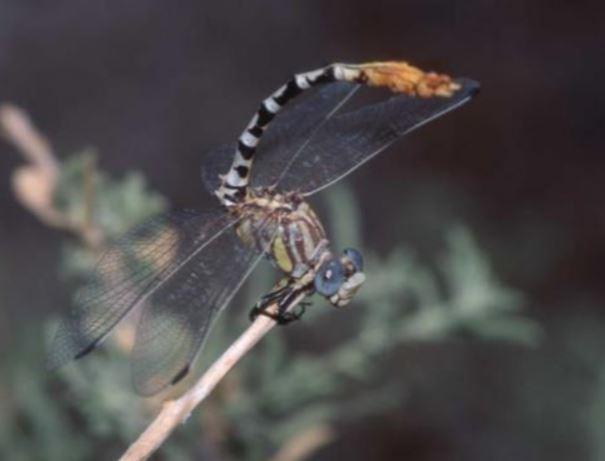Moderate-
High
The population size of the white-belted ringtail in Washington is low and its population trend is unknown.
Description and Range
Physical description
White-belted ringtail is a dragonfly in the family Gomphidae.
Ecology and life history
White-belted ringtail uses open sandy streams and rivers, irrigation ditches, and occasionally sink holes; the species is typically in desert country associated with sagebrush-riparian woodland.
Clubtail dragonflies complete a life cycle composed of two main phases: a flightless aquatic larva (nymph stage), which may be continuous for one to two winters, and the adult flight (reproductive stage). They inhabit sites year-round as egg, larval nymph, and adult, typically moving within only a few to several hundred meters of their natal locations. Adults do not seasonally migrate and die soon after their reproductive summer.
Both life stages are predatory; the majority of life cycle is spent as aquatic larvae. Nymphs feed on aquatic invertebrates and possibly small vertebrates (fish, frog and salamander larva). After multiple aquatic instars (gradual metamorphosis) over one or two winters, mature nymphs crawl onto rocks or vegetation and shed their exoskeleton to become a new adult (teneral) in late spring and summer.
Adults are aerial predators of smaller insects and similar sized butterflies and moths (Lepidoptera), as well as smaller Odonates.
Water temperature influences the timing of emergence from within a year or over two years. Weather influences flight period duration, with wet or cold conditions potentially shortening the flight period and warm, dry conditions promoting the duration and later occurrence dates of the flight period.
Male clubtails seek mates by patrolling a territory that coincides with optimal aquatic habitat for female egg-laying, and hence for larvae. There is usually no courtship behavior. After copulation, females usually hover just above the water of slow moving or gentle current stretches and close to shore while periodically dipping the tail to deposit multiple eggs.
Geographic range
The overall range of white-belted ringtail includes the southern part of the Columbia Basin in Washington as well as California, Idaho, Oregon, Nevada, Arizona, New Mexico and Texas.
For a range-wide map and conservation status of this species, check out NatureServe Explorer.
Climate vulnerability
Sensitivity to climate change
Moderate-
High
There is little information on the sensitivity of this species to climate change, but similar to the Pacific clubtail, it is likely influenced by air temperature, water temperature, and shifting flow regimes. Temperature is known to influence the phenology, development, behavior and other characteristics of dragonflies, and warming temperatures (both air and water) will likely impact this species during various life stages. Hydrological changes (e.g., reduced stream flows) and drought may degrade or reduce aquatic habitat available for this species and/or compound increases in water temperature. White-belted ringtail is also likely sensitive to disturbance events (e.g., fire, floods) that reduce riparian vegetation, which eliminates stream shade and foraging and roosting sites for adults, and/or that increase siltation, which can kill larvae.
Exposure to climate change
Moderate
- Increased air and water temperatures
- Altered flow regimes (low summer flows and increased winter flooding)
- Altered fire regimes
Conservation
Research is needed to quantify specific habitat requirements for this species, including aquatic larval substrates, river and stream, or lake and pond characteristics, and other key habitat features.
Conservation Threats and Actions Needed
- Agriculture and aquaculture side effects
- Threat: Pesticide and fertilizer runoff and streams
- Action Needed: Monitor occurrence waters for chemical contaminates
- Threat: Siltation and degradation of stream and bottom habitat used by developing larvae by unsustainable grazing, commercial or recreational uses.
- Action Needed: Work to improve unsustainable grazing and commercial use practices in waters of known occurrence
- Fish and wildlife habitat loss or degradation
- Threat: Vulnerable mostly because of extreme rarity of any known populations
- Action Needed: Efforts that protect water quality most important to larval development. Use land acquisitions, conservation easements and landowner agreements to protect significant shoreline areas from degradation.
- Threat: Loss of riparian vegetation that provide shade and perch sites; ameliorates stream temperatures
- Action Needed: Monitor vegetation around known occurrence sites
- Invasive and other problematic species
- Threat: Introduced predatory fish species that may not have co-evolved with these species.
- Action Needed: Monitor streams in context of non-native aquatic species.
- Climate change and severe weather
- Threat: Increased environmental temperatures may affect life history with unknown consequences
- Action Needed: Monitor streams in context of climate changes
See the Climate vulnerability section for more information about the threats posed by climate change to this species.
Resources
References
Hassall C. and D.J. Thompson. 2008. The effects of environmental warming on Odonata: a review. International journal of Odontology 11:131-153.
Paulson, D.R. 2014. Washington Odonata. Slater Museum of Natural History, University of Puget Sound, Tacoma. Sept 2014. http://www.pugetsound.edu/academics/academic-resources/slater-museum/biodiversityresources/dragonflies/washington-odonata/ [old link]
Paulson, D.R. 2009. Dragonflies and damselflies of the West. Princeton University Press, Princeton, NJ.
USFS-BLM. 2008c. Species fact sheet: White-belted Ringtail (Erpetogomphus compositus). Prepared by S. Foltz. Xerces Society for Invertebrate Conservation, Portland, Oregon.
